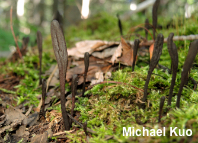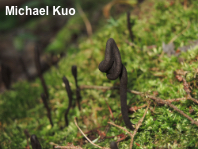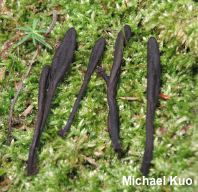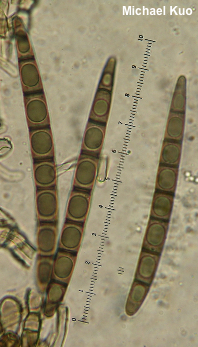| Major Groups > Clubs & Corals > Geoglossum simile |

|
Geoglossum simile [ Ascomycota > Geoglossales > Geoglossaceae > Geoglossum ... ] by Michael Kuo Should we count the dividing lines (the septa), or the spaces between the lines? Are Geoglossum simile spores 7-septate or 8-sectioned? When the goal was scored in the 24th minute, the clock read 23-something. Dates in the 19th century start with "18." What the hell is going on? Why does my cat have a large smudge of dirt on his forehead? What has he been up to? He has lost his mind, you say . . . but I challenge you to come up with something entertaining to say about Geoglossum simile. It's a Geoglossum. It looks like all the others until you study it with a microscope, at which point you discover that the combination of 7-septate spores and long paraphyses with barrel-shaped sections toward their apices makes the species distinct. Description: Ecology: Saprobic; growing gregariously, often in moss, on the ground in hardwood and conifer forests; sometimes growing on moss-covered logs; summer and fall; originally described from upstate New York; widespread in North America east of the Great Plains, and in northern and central Europe. The described and illustrated collection is from Michigan. Fruiting Body: Club-shaped, with a well defined head that is clearly separate from the stem; 2.5–7 cm high. Head: 3–6 mm wide; often flattened; becoming wrinkled or grooved longitudinally; black; finely scurfy or bald; dry. Stem: 2–4 mm wide; finely scurfy-pimply; black or, near the apex or base, dark brown; dry; basal mycelium dark gray. Flesh: Thin; black, or whitish in the center. Odor: Not distinctive. Microscopic Features: Spores 86–100 x 6–11 µm; subfusiform; smooth; predominantly 7-septate (occasionally 9-septate); brown in KOH, with darker septa. Asci 8-spored; 150–180 x 20–25 µm; fusiform. Paraphyses 4–5 µm wide; filiform; exceeding the asci by 10–60 µm; septate, becoming more frequently so toward apex, where barrel-shaped cells up to 8 µm wide predominate, often with constrictions at every other septum; brownish-walled in KOH. Cauloparaphyses similar to paraphyses but shorter; not gelatinized. REFERENCES: C. H. Peck, 1873. (Nannfeldt, 1942; Seaver, 1951; Mains, 1954; Smith, Smith & Weber, 1981; Miller & Miller, 2006; Beug et al., 2014; Hustad et al., 2014.) Herb. Kuo 08112003. This website contains no information about the edibility or toxicity of mushrooms. |
© MushroomExpert.Com |
|
Cite this page as: Kuo, M. (2022, June). Geoglossum simile. Retrieved from the MushroomExpert.Com Web site: http://www.mushroomexpert.com/geoglossum_simile.html |




